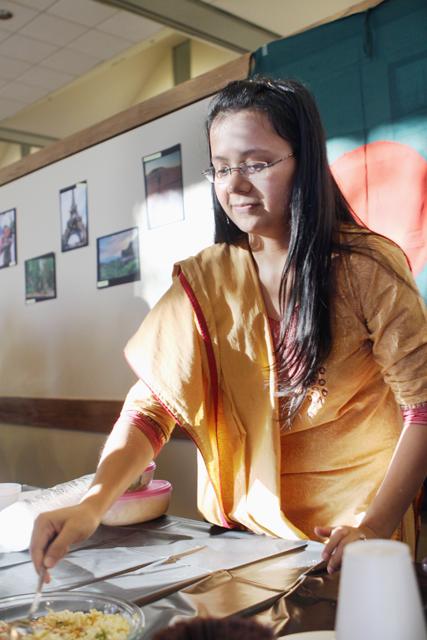The impression many Americans have of tea falls along the lines of a bitter cup of Lipton or the diabetes-inducing sweetness of a southern iced tea. Yet around the world, tea is an integral part of culture that is hardly overlooked.
After water, tea is the second most consumed beverage in the world, and the tremendous amount of tea drunk carries a large cultural element. It is no wonder CHASS International Programs and the Office of International Services (OIS) hosted International Tea and Coffee, an event to demonstrate the significance tea and coffee carry in other cultures and a way to deliver a much-appreciated caffeine buzz to sleep-deprived students.
CHASS International Programs and the OIS organized the event in light of International Education Week 2010, which is sponsored by the State Department, according to Lauren Ball, program coordinator of the OIS. Throughout the week, the University offered various educational opportunities to help broaden students horizons.
“It’s a way to bring in American students to learn about other countries,” Erin Moody, manager of OIS, said.
Students representing various countries including China, Thailand, India, Bangladesh, Iran, Turkey and Saudi Arabia shared teas, coffees and desserts on Wednesday in the Caldwell Lounge to a crowd of students curious to learn more about tea cultures.
Throughout Africa, the Middle East, South Asia and East Asia, tea is a social medium that has been integrated into hospitality for millennia.
“Whenever you invite someone over, you always serve tea,” Behzad Nabavi, an Iranian graduate student in electrical engineering, said. “It would be rude not to offer tea.”
Tea is native to South and East Asia and once its flavor, medicinal and caffeine qualities were discovered, it quickly became an integral part of continental Asian culture. The long tradition of tea made its way west into the Middle East, North Africa and eventually into Europe, in which the tea and spice trade maintained enormously powerful empires in India, Persia and Turkey. Consequentially, tea is a daily ritual in these regions of the world.
“Tea is a big part of Indian culture,” Kalyan Palaparthy, a graduate student in mechanical engineering, said. “People do drink coffee, but most drink tea.”
Along with the tea provided by the student representatives, Mike Ritchy, the owner of Global Village Coffeehouse, provided additional coffee, tea and sweets to the event.
“The coffees we provided are coffees from Indonesia that we roasted here,” Ritchey said. “Here in the states, we haven’t quite captured the essence of coffee or tea. For us, it’s a quick, on-the-go thing. It’s like self-medication. However, in the rest of the world, it’s more of a social thing…I hope this event is able to bring a lot of Americans to take a look into the way that other cultures view tea and coffee.”
Despite the fact that all teas derive from essentially the same hybrid of Camellia sinensis, tea can be dried, flavored, prepared and enjoyed in a variety of ways. Moroccans tend to flavor their preferred green tea with mint and amounts of sugar that scream “pass the insulin,” while other cultures, like that of China, Japan and Korea, prefer to drink tea plain.
“In Iran, we use sugar cubes,” Banadaki said. “However, we don’t mix it in the teacup. We put the little sugar cubes in our mouth and then we drink the tea.”
However, tea is only one factor to the offering of hospitality. Tea drinkers take the side dishes just as seriously.
“We eat a lot of lokum, the Turkish word for Turkish delight, along with our tea,” Mustafa Berke Yelten, a Turkish doctoral student in electrical engineering, said. “Turkish delight is a sweet dessert and has a old and strong reputation in Turkey and around the world. I am from Istanbul, and for example, in Muslim countries we are celebrating Eid al Adha, so what we do is visit friends and serve tea and eat lokum.”
Along with tea, Turkey has strong coffee drinking habits. Turkish coffee has a reputation of being very bold, bitter and powerful.
“We drink coffee throughout the day,” Yelten said. “Tea, like U.K. tradition, is served at 5:00 p.m.”
Just like tea, coffee comes in all shapes and forms. The Arabian Peninsula, Saudi Arabia in particular, has a unique tradition of preparing coffee.
“We have a special coffee,” Hussain AlShabaan, a Saudi sophomore in mechanical engineering, said. “When a lot of people see it, they think it’s like a green tea. It is made with saffron and cardamom.”
Arabic coffee has a slight sweetness from the cardamom spice and would appear to be nothing like coffee consumed in the U.S. Arabic coffee is lightly roasted, so the color of the beverage is a slight yellow.
“Whenever a guest comes to visit, we drink coffee first, then tea, eat a little dessert and then drink coffee again,” AlShabaan said. “Also, there are special ways to drink it. For example, if I’m serving coffee, I must hold the pot with my right hand, pour it into the cup I’m holding with my left hand and then serve it to the guest in my right hand. The older people really take this part seriously.”
American coffee and tea drinking culture focuses more on the chemical composition of the beverage rather than its function of a social medium, but that idea is slowly changing.








